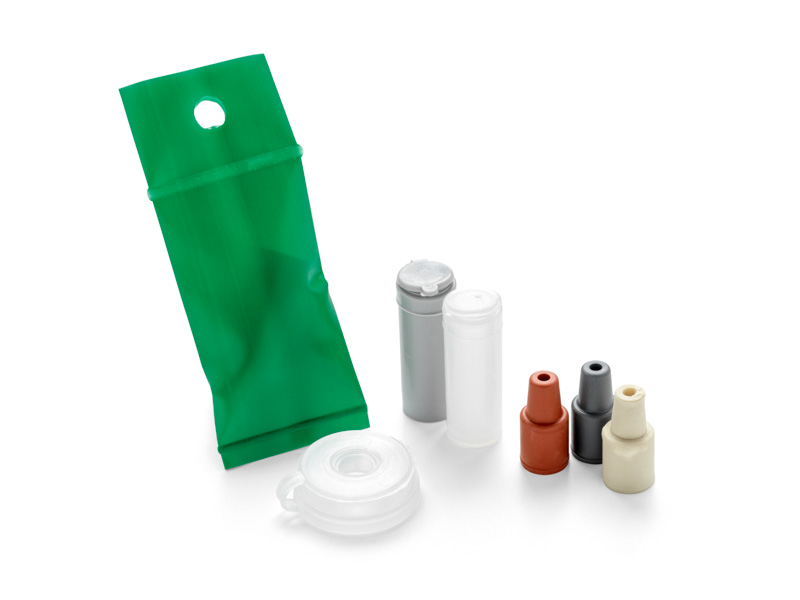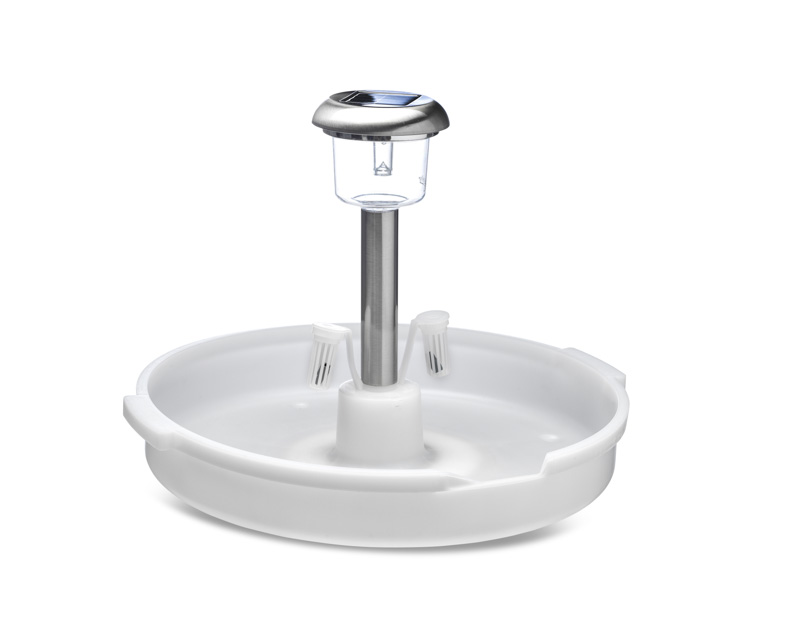
The western flower thrips has spread around the world through international trade. Its ability to breed on many species of host plants (>240 known hosts), and its ability to develop resistance to insecticides, has contributed to its success. Symptoms of plant damage by thrips feeding include: bud deformation, shape distortion of fruits or vegetables during growth and a range of leaf spots, scars, silvering and bronzing. Both adult and larvae feed throughout the plant and leave the crop susceptible to secondary fungal and bacterial infection resulting in moulding and wilting. The western flower thripsis a vector of some important virus diseases such as Tomato Spotted Wilt Virus (TSWV) and Impatiens Necrotic Spot Virus (INSV). Entire crops may be left unmarketable unless infestations are managed.
Russell IPM offers a range of strategies to improve management of thrips. Mass-monitoring with Optiroll blue super plus with a species-specific aggregation pheromone and push-pull strategies combining Magipal with traps and lures contribute to reducing western flower thrips numbers and crop damage. A range of traps can be used for monitoring including blue or yellow sticky traps and Ferolite light traps. The Russell IPM kairomone thrips attractant, Thripnok, that attracts a range of thrips species, and the western flower thrips aggregation pheromone lures can be added to traps to increase trap catch.
Biology
Thrips have six life stages which includes the egg, two larval, prepupal, pupal and adult stages. Eggs are laid inside leaves, flower structures or fruit. In some cases this can result in wart-like growths but in others it is undetectable.
Larvae feed on leaves and pollen, maturing through two instars. They are often concealed in well-protected plant parts such as within flowers or under the calyx of fruits. Most pupae fall to ground to pupate.
Adult thrips emerge with slender, fringed wings in order to take flight. Males and female aggregate in prominent positions for mating.
Larvae mature through two instars in concealed and well-protected plant parts such as within flower petals or under the calyx of fruits. In heavy infestations the larval will become mobile as they attempt to nourish upon all parts of the plant that are above ground. Most thrips, including western flower thrips, fall to the ground in order to pupate.
Finally, the adult thrips will emerge with slender and fringed wings in order to take flight and seek a partner for reproduction.
Nature of Damage
Western flower thrips feeding can result in severely damaged crops. Growers may notice visible signs of damage such as bud and fruit deformities and a blackening of the skin. Female thrips lay their eggs on crops and fruits, resulting in bronzing and silvering on fruit, leaves and petals.
Both adult and larvae feed throughout the plant and leave the crop susceptible to secondary fungal and bacterial infection resulting in moulding and wilting. The western flower thrips is a vector of some important virus diseases such as Tomato Spotted Wilt Virus (TSWV) and Impatiens Necrotic Spot Virus (INSV).
Monitoring
Installation of blue sticky traps such as Optiroll sticky roller traps and Impact Blue boards from Russell IPM can provide a simple and effective monitoring system for the western flower thrips. Adding lures increases trap catch, selecting the western flower thrips aggregation pheromone for a species-specific lure, or Thripnok, to attract a range of thrips species.
Application Guidelines
The following notes are guidelines of general nature and meant to give the user a head start in implementing a thrips monitoring program. Local conditions and practices can vary, so seek the advice of local advisers for more detailed advice.
Lures
The western flower thrips aggregation pheromone lures can be changed every 6-8 weeks to get the most accurate results.
Thripnok remains active as long as there is liquid visible in the blister pack, which is up to three months in cool conditions.
Lures handling
Pheromone lures are a very sensitive tool. They can be affected by exposure to elevated heat and direct sunshine. Wear gloves to handle the lures as direct touching by hand may cause cross contamination leading to mixed catches in the trap. Some contaminants, such as nicotine, may have a repellent effect reducing trap catch.
Lure Storage
The western flower thrips aggregation pheromone lures can be stored for long periods (several years) in a freezer (at about -20˚C) if the pack is sealed. Lures can also be stored in a fridge at higher temperatures (4˚C) for periods of up to 1 year. Although the pheromone is not harmful to humans, lures should not be kept in a freezer or fridge where food is stored.
The Thripnok blister pack lures can be stored for up to a year at room temperature as long as the foil backing has not been removed.
Trap Selection
Optiroll Blue and Impact Board Blue are the most sensitive traps to use for monitoring and trapping western flower thrips. Optiroll Super traps have white patterns on the traps that increase trap catch by approximately 25%. Optiroll super plus (thrips) rolls are the best performing traps, including an attractive pattern and the western flower thrips aggregation pheromone incorporated into the glue.
Monitoring traps can be used in conjunction with the western flower thrips aggregation pheromone lures to increase catch rate and enhance specificity of the trap. Traps can also be combined with the kairomone lure, Thripnok, which is useful for increasing trap catch in crops where there are of a number of different flower-inhabiting thrips species present, typically tripling trap catch.
Yellow traps catch fewer western flower thrips compared to blue traps in summer conditions, but may be useful when you want to monitor other pest species, such as whiteflies and aphids, on the same traps.
Trap Density
For Optiroll sticky roller traps, attach them to the greenhouse posts, hanging them just above crop height, using about 10 traps per hectare, depending on structure of the greenhouse.
For Impact Boards, hang traps at regular intervals amongst the crop rows, taking care to avoid contact between the trap and plant canopy. For heavy infestations place 1 board every 10 m2. For monitoring, place 1 board in every ~250m2.
Trap Position
Position traps and lures just above the crop (e.g with the base of the trap 10 cm above the crop) or place parallel with the crop rows, taking care to avoid contact between the roll and plant canopy. Position the traps so that they are clearly visible in the crop, but not too far from flower height, as thrips are poor fliers.
Data and Interpretation
Collect data weekly throughout the season. For mass trapping apply the roller traps from the start of cropping as they are a preventative treatments to be used alongside biological control options. Decisions on pesticide application should not be taken solely on the trap catch data. Climatic and biological considerations should be taken in account.
Sampson, C. & Kirk, W. D. J. (2013) Can Mass Trapping Reduce Thrips Damage and Is It Economically Viable? Management of the Western Flower Thrips in Strawberry. PLOS One (2013)
The western flower thrips, Frankliniella occidentalis is a cosmopolitan, polyphagous insect pest that causes bronzing to fruit of strawberry (Fragaria x ananassa). The main aim of this study was to test whether mass trapping could reduce damage and to predict whether this approach would be economically viable. In semi-protected strawberry crops, mass trapping of F. occidentalis using blue sticky roller traps reduced adult thrips numbers per flower by 61% and fruit bronzing by 55%. The addition of the F. occidentalis aggregation pheromone, neryl (S)-2-methylbutanoate, to the traps doubled the trap catch, reduced adult thrips numbers per flower by 73% and fruit bronzing by 68%. Damage that would result in downgrading of fruit to a cheaper price occurred when bronzing affected about 10% of the red fruit surface. The addition of blue sticky roller traps to an integrated pest management programme maintained thrips numbers below the damage threshold and increased grower returns by a conservative estimate of £2.2k per hectare.
Sampson, C. & Kirk, W. D. J. (2012) Flower stage and position affect population estimates of the western flower thrips, Frankliniella occidentalis (Pergande), in strawberry. Acta Phytopathologica, 2012.
An accurate estimate of a population is essential for pest management. For Frankliniella occidentalis (Pergande) in strawberry, counts of thrips in flowers are commonly used as there is a strong correlation between thrips number per flower and fruit damage. The aim of this study was to look at the abundance and population structure of thrips within different flower stages and positions on the plant to test whether these affect population estimates. Adult females were found in open buds (petals showing), but were most frequent in young and mature flowers, whereas adult males were not found in buds and were most frequent in mature and senescent flowers. Twice as many adult thrips were found in mature flowers at the top of the plant compared to those at the side. Only larvae were found in closed buds (no petals showing). Larval numbers increased gradually with flower stage and peaked in senescent flowers. The choice of flower stage and position for sampling could affect population estimates by as much as a factor of four.








